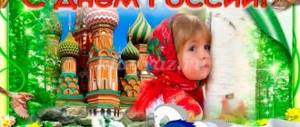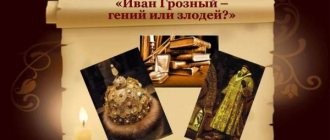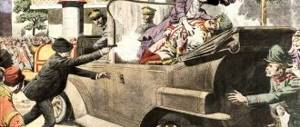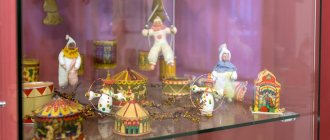Time of Troubles, its causes and features
The Time of Troubles is a historical period from 1598 (began with the death of Fyodor Ivanovich Rurikovich) to 1613 (ended with the election of Mikhail Romanov to the throne). Contemporaries of the Time of Troubles called these years in Russia the hard times.
Distinctive features of the Time of Troubles:
- the fierce struggle of various boyar families for power;
- the dynastic crisis and the subsequent period of “kingdomlessness”;
- the economic crisis that led the country to global economic ruin;
- imposture;
- invasion of Russian lands by foreign invaders;
- Civil War.
Let's memorize new words!
Civil war is an armed confrontation between citizens of one state.
The Time of Troubles began with the interruption of the Moscow royal dynasty - the Rurikovichs. After the death of Ivan the Terrible’s son, Fyodor Ivanovich, there were no direct heirs of this royal family left in the Russian state.
The absence of a legitimate tsar in Russia coincided with natural disasters, famine, desolation of the central lands, economic ruin and spiritual decline.
In addition to the dynastic crisis, it is necessary to highlight other important causes of the Troubles :
- Disunity within the ruling class - in the ranks of the boyars and nobles, which led to numerous conflicts with the tsarist authorities and clashes of interests.
- The lean years of 1601-1604 and the associated famine, the ruin of large and small farms, economic devastation.
- Impoverishment of service people, artisans, traders, Cossacks.
- Significant increase in taxes for the tax-paying population.
- The tightening of the policy of enslaving peasants is the final legislative consolidation of serfdom in the country.
Let's memorize new words!
Service people are citizens of Russia from the 15th to the 18th centuries who were in public service.
Tax-paying people are certain groups of the Russian population (mainly peasants, artisans and traders) who paid the poll tax - a tax levied by the state on each “soul” in the same amount.
Serfdom is an extreme form of dependence of peasants on their owners, in which serfs are attached to the land of the landowner and do not have the right to leave his land plots.
Reasons for the start of the Time of Troubles
Ivan the Terrible had three sons. He killed his eldest son in a fit of rage; the youngest was only two years old, and the middle one, Fyodor, was 27. Thus, after the death of the tsar, it was Fyodor who had to take power into his own hands. But the heir is a soft personality and was not at all suitable for the role of ruler. During his lifetime, Ivan IV created a regency council under Fedor, which included Boris Godunov, Shuisky and other boyars.
Ivan the Terrible died in 1584. Fedor became the official ruler, but in fact it was Godunov. A few years later, in 1591, Dmitry (the youngest son of Ivan the Terrible) dies. A number of versions of the boy's death have been put forward. The main version is that the boy accidentally ran into a knife while playing. Some claimed that they knew who killed the prince. Another version is that he was killed by Godunov’s henchmen. A few years later, Fedor dies (1598), leaving no children behind.
This is interesting: Andrei Bogolyubsky - Wikipedia, short biography.
Thus, historians identify the following main reasons and factors for the beginning of the Time of Troubles:
- Interruption of the Rurik dynasty.
- The desire of the boyars to increase their role and power in the state, to limit the power of the tsar. The boyars' claims grew into an open struggle with the top government. Their intrigues had a negative impact on the position of royal power in the state.
- The economic situation was critical. The king’s campaigns of conquest required the activation of all forces, including production ones. In 1601–1603 there was a period of famine, as a result - the impoverishment of large and small farms.
- Serious social conflict. The current system rejected not only numerous fugitive peasants, serfs, townspeople, city Cossacks, but also some parts of the service people.
- Domestic policy of Ivan the Terrible. The consequences and results of the oprichnina increased distrust and undermined respect for law and authority.
This is interesting: the beginning of the tsar’s struggle with the boyars was the convening of the first Zemsky Sobor.
Reign of False Dmitry I
With the beginning of the Time of Troubles, boyar Boris Godunov ascended to the Moscow throne. A 3-year famine that coincided with the period of his reign embittered the population and turned them against the king. There were rumors that Boris killed the rightful heir from the Rurik family - Tsarevich Dmitry.
In 1604, the famine ended, the long-awaited harvest ripened, but the country could not recover from the devastation for a long time. The central regions of the state were deserted, hungry and dissatisfied peasants fled to the south away from the Moscow authorities. Godunov tightened laws to curb the exodus of peasants, and they, in turn, raised uprisings on the outskirts of the country.
The appearance of an impostor
Under these conditions, a rumor spread throughout Moscow that Tsarevich Dmitry did not die, miraculously survived Godunov’s assassination attempt and was preparing to take revenge on him - to return his rightful throne. The rumor was started by an impostor - Grigory Otrepiev - a monk of the Chudov Monastery, who fled from Russia to the Polish-Lithuanian Commonwealth. The Polish king liked the impostor's plan: Gregory asked for money and military assistance to take the Russian throne, and in return promised to transfer some Russian lands to Poland and establish Catholicism in Russia.
Before the country had time to recover from famine, in 1604 False Dmitry I with a small Polish detachment crossed the border of the Russian state. He was joined by fugitive peasants who lived on the southern outskirts of the country, townspeople dissatisfied with the government and Cossacks. Gradually, the small detachment of False Dmitry turned into a large army. In January 1605, the army of Grigory Otrepiev was defeated by Boris Godunov, but on April 13, the tsar unexpectedly died. Moscow military personnel and citizens went over to the side of the impostor.
False Dmitry I on the Russian throne
In July 1605, the Moscow people proclaimed False Dmitry I the new Russian Tsar. The boyars also recognized him as the legal heir. In the first months of the reign of False Dmitry I, a fight was waged against extortion and bribery, executions were abolished, and he returned from exile the boyars who had suffered under Godunov. But very soon the people became disillusioned with the new tsar - he rejected Orthodox customs and wore Polish clothes. Poles came to Moscow and behaved impudently and unceremoniously with Moscow residents.
The wedding of False Dmitry and Marina Mnishek (daughter of the Polish governor) finally turned the people against the impostor. More than 2,000 Poles came to Moscow, who behaved brazenly and unceremoniously with Moscow residents, robbed them and beat them. The boyar nobility was also dissatisfied with the reign of False Dmitry I - he did not fulfill his promises and removed the boyars from managing state affairs. As a result of the uprising of the boyars on May 17, 1606 , the impostor was killed and his wife was sent into exile.
The appearance of False Dmitry II
After the execution of False Dmitry, the Russian prince Vasily Shuisky . He directed all efforts to stabilize the situation in the country. But soon, in the summer 1607 , a new impostor appeared in Russia - False Dmitry II. It was a traveling teacher, a Jew named Bogdanko. With the support of Poland, he was transported to the southwestern outskirts of the country.
False Dmitry II was similar in figure and face to False Dmitry I, the new impostor stated that in 1606 his double was killed, and he himself escaped and fled from the state. Despite the fact that False Dmitry I and False Dmitry II were two different people, Marina Mnishek recognized Bogdanko as her husband.
With his army, consisting of Polish soldiers and the Russian people dissatisfied with the rule of Vasily Shuisky, the impostor settled in the village of Tushino near Moscow. The people called False Dmitry II the Tushino thief, as his troops devastated villages and ruined local residents.
From 1608 to 1610, during the reign of Vasily Shuisky, two state centers were formed in Russia - in Moscow and in Tushino. All this time, the impostor made attempts to take Moscow. To fight the Tushino thief, the Moscow government asked for help from Sweden. Swedish troops helped the Moscow government recapture the northeastern part of Russia from the impostor.
Time of Troubles (Time of Troubles) briefly
1598-1613 - a period in Russian history called the Time of Troubles.
At the turn of the 16th and 17th centuries, Russia was experiencing a political and socio-economic crisis. The Livonian War and the Tatar invasion, as well as the oprichnina of Ivan the Terrible, contributed to the intensification of the crisis and the growth of discontent. This was the reason for the beginning of the Time of Troubles in Russia.
The first period of unrest is characterized by the struggle for the throne of various pretenders. After the death of Ivan the Terrible, his son Fedor came to power, but he turned out to be unable to rule and was actually ruled by the brother of the tsar’s wife, Boris Godunov. Ultimately, his policies caused discontent among the popular masses.
The Troubles began with the appearance in Poland of False Dmitry (in reality Grigory Otrepiev), the allegedly miraculously surviving son of Ivan the Terrible. He won over a significant part of the Russian population to his side. In 1605, False Dmitry was supported by the governors, and then Moscow. And already in June he became the legitimate king. But he acted too independently, which caused discontent among the boyars; he also supported serfdom, which caused protest from the peasants. On May 17, 1606, False Dmitry I was killed and V.I. ascended the throne. Shuisky, with the condition of limiting power. Thus, the first stage of the Troubles was marked by the reign of False Dmitry I (1605 - 1606)
Second period of troubles . In 1606, an uprising arose, the leader of which was I.I. Bolotnikov. The ranks of the militia included people from different walks of life: peasants, serfs, small and medium-sized feudal lords, servicemen, Cossacks and townspeople. They were defeated in the battle of Moscow. As a result, Bolotnikov was executed.
But dissatisfaction with the authorities continued. And soon False Dmitry II appears. In January 1608, his army headed towards Moscow. By June, False Dmitry II entered the village of Tushino near Moscow, where he settled. In Russia, 2 capitals were formed: boyars, merchants, officials worked on 2 fronts, sometimes even receiving salaries from both kings. Shuisky concluded an agreement with Sweden and the Polish-Lithuanian Commonwealth began aggressive military operations. False Dmitry II fled to Kaluga.
Shuisky was tonsured a monk and taken to the Chudov Monastery. An interregnum began in Russia - the Seven Boyars (a council of 7 boyars). The Boyar Duma made a deal with the Polish interventionists and on August 17, 1610, Moscow swore allegiance to the Polish king Vladislav. At the end of 1610, False Dmitry II was killed, but the struggle for the throne did not end there.
So, the second stage was marked by the uprising of I.I. Bolotnikov (1606 - 1607), the reign of Vasily Shuisky (1606 - 1610), the appearance of False Dmitry II, as well as the Seven Boyars (1610).
The third period of unrest is characterized by the struggle against foreign invaders. After the death of False Dmitry II, the Russians united against the Poles. The war acquired a national character. In August 1612, the militia of K. Minin and D. Pozharsky reached Moscow. And already on October 26, the Polish garrison surrendered. Moscow was liberated. The time of troubles is over.
On February 21, 1613, the Zemsky Sobor appointed Mikhail Romanov as Tsar.
The results of the turmoil were depressing: the country was in a terrible situation, the treasury was ruined, trade and crafts were in decline. The consequences of the Troubles for Russia were expressed in its backwardness compared to European countries. It took decades to restore the economy.
Seven Boyars
The elderly Vasily Shuisky did not have children to whom he could pass the Russian throne. In addition to this reason, the king was not popular among the people due to his weak-willed character. In July 1610, Shuisky's associates hatched a conspiracy, overthrew Vasily from the throne, and forced him to enter a monastery.
In Russia, the times of the Seven Boyars - the state was headed by a provisional government of seven noble boyars led by Fyodor Ivanovich Mstislavsky. It was decided that the Seven Boyars would rule the country until the Zemsky Sobor elected a new king.
Let's memorize new words!
The Zemsky Sobor is a national advisory body in Russia of the 16th-17th centuries, consisting of all segments of the population and convened to discuss the most important issues.
In fact, the power of the new government did not extend beyond Moscow. Returning from Kaluga, False Dmitry II settled in the royal residence in Kolomenskoye. The army of the Polish commander Stanislav Zholkiewski was stationed in another village near Moscow.
The Seven Boyars were afraid that under these conditions the people would support False Dmitry II and elevate him to the throne. Then the cunning boyars entered into a secret agreement with Stanislav Zholkiewski, according to which the Polish prince, Vladislav, would be elected as the next Russian Tsar. The boyars opened the way to Moscow for Zholkiewski so that the Polish army would defeat the Tushino thief. False Dmitry II was preparing to retreat through Voronezh, but was killed by the Tatar prince during a horseback ride.
The Poles helped expel the impostor, but they were also in no hurry to leave Moscow. The Polish-Lithuanian troops behaved in Moscow like conquerors, and representatives of the seven-boyars became hostages to foreigners.
Smuta The presentation was made by 10th grade student Mursalova M. - presentation
Smuta The presentation was made by 10th grade student Mursalova M.
Troubles at the beginning of the 17th century. Troubles (time of troubles) is a historical period in Russian history at the beginning of the 5th century, when the country was experiencing a systemic, political, economic and social crisis. from 1598 to 1613
Causes of the Troubles Dynastic crisis (the end of the Rurik dynasty) The struggle of boyar groups for power. Intervention of neighboring states (Poland, Sweden) Social crisis (dissatisfaction with their position of all social groups)
Stages Boris Godunov Years of reign: gg.Years of reign: gg. False Dmitry I Years of reign: gg. Vasily Ivanovich Shuisky
Course of events Boris Godunov A sharp change in the nature of the domestic and foreign policy of the state (development of the southern outskirts, development of Siberia, return of western lands, truce with Poland).
Domestic policy Rejection of the policy of mass terror; The desire to consolidate the entire class of landowners; Measures during famine: Allowing the transfer of peasants from one owner to another Freeing slaves whom the landowner could not feed Free distribution of bread Organization of work paid for with bread
Fixed prices, punishment of speculators Supported the townspeople, eased the situation of those who were engaged in crafts and trade. He did everything possible to revive the catastrophically fallen crafts and trade. Widespread construction of cities in the Volga region Supported the liberation of the Orthodox Church from formal dependence on Constantinople; 1589 – establishment of the patriarchate.
Foreign policy Strengthened and expanded the country's borders. Improved the defensive structures of Moscow and Smolensk. The Solovetsky Monastery became an impregnable fortress. Russia's international authority has increased. Avoided wars with neighbors (15-year truce with Poland). Russia received Ivangorod, Yam, Koporye, and access to the Baltic Sea. Expansion of international relations.
Results A shrewd and cautious policy aimed at reviving the economy and increasing Russia's international prestige allowed the conflict to be postponed, but not prevented. He was given the most difficult task - overcoming the terrible consequences of the oprichnina (economic crisis, disunity of the population). An unprecedented step - sending 18 noble children abroad to study. Opened the doors wide to foreign specialists (the first attempt at modernization).
Policy of False Dmitry I The policy of False Dmitry I was built on generosity and mercy towards his subjects. He brought back from exile the nobles expelled from Moscow under his predecessors, doubled the salaries of military personnel, increased land plots for landowners, and abolished taxes in the south of the country. But since this only emptied the treasury, Tsar False Dmitry I increased taxes in other regions. Riots began to grow, which False Dmitry refused to extinguish by force, but instead allowed the peasants to change the landowner if he did not feed them. "The entry of the troops of False Dmitry I into Moscow." K.F. Lebedev
In foreign policy, he immediately began preparing a war with the Turks in order to conquer Azov and seize the mouth of the Don. For a successful war, the king wanted to enter into an alliance with Western countries, but was refused because he had not previously fulfilled his promises.
Death of False Dmitry May 17, 1606 - Uprising in Moscow against False Dmitry 1. Murder of False Dmitry, arrest of Marina Mnishek and her father.
Vasily Shuisky The period of the reign of Vasily IV Shuisky (year) Events: Bolotnikov’s uprising (Putivl-Moscow) October siege of the village of Kolomenskoye near Moscow Betrayal of the nobles, Dec defeated near Kolomensk - to Kaluga + detachments of “Tsarevich Peter” - impostor Ilya Goncharov (betrayed for the son of Fedora) - to Tula. Siege 3 months. River Upa, dam, flooded Tula decree on a 15-year investigation June December period of “dual power”, the reign of the self-proclaimed Russian Tsar - False Dmitry invasion of False Dmitry 2. (appeared in October In Putivl. March on Moscow. June captured Tushino.
Foreign policy July defeat with the Poles near the village. Klushino near Mozhaisk, an unsuccessful attempt by False Dmitry 2 to take Moscow. February treaty with Sweden against False Dmitry 2. September invasion of Polish troops. Siege of Smolensk (Sigismund). The beginning of the Polish-Swedish intervention. Dec Polish troops from Tushino - to Sigismund to Smolensk, the alliance of Vasily Shuisky with Sweden and the successful actions of Russian-Swedish troops under the command of M. Skopin-Shuisky against the troops of False Dmitry II. January FIRST embassy of Tushino residents to Sigismund (Saltykov). June defeat of Shuisky's troops by the Poles near Mozhaisk Polish-Swedish intervention.
Overthrow of the Tsar After the defeat of False Dmitry II, the unrest did not stop. Shuisky's difficult position in Moscow was aggravated by the intensified struggle for power. Vasily Galitsin and Prokopiy Lyapunov attempted to rouse the people against the current tsar. At the same time, under unclear circumstances, Skopin-Shuisky died suddenly. On June 24, 1610, Shuisky's troops were defeated by the Polish army under the command of Hetman Stanislav Zolkiewsky. There was a danger that the Russian throne would be taken by the Polish prince Vladislav. Shuisky was unable to oppose anything to the Polish onslaught, for which he was deposed by the Moscow boyars in July 1610. Vasily Shuisky was forcibly tonsured together with his wife as a monk, and after Hetman Stanislav Zholkiewski entered Moscow, he was transported to Warsaw, where he died while in custody.
The Seven Boyars The Seven Boyars is a government that operated during the Time of Troubles for years. It functioned until the liberation of the Second People's Militia of Moscow in October 1612. It was elected in Moscow after the overthrow of Vasily Shuisky in July 1610
Composition: Prince F.I. Mstislavsky - Head of Government, Prince I.M. Vorotynsky, Prince A.V. Trubetskoy, Prince A.V. Golitsyn, Prince B.M. Lykov-Obolensky boyar I.N. Romanov boyar F.I. Sheremetev
Activities of the Seven Boyars August the conclusion of an agreement with Poland on the election of Prince Vladislav, the son of the Polish king Sigismund, to the Russian throne 3. According to the agreement, Vladislav had to convert to Orthodoxy, marry a Russian, limit the number of close associates from Poland, etc. On September 21, the Polish army secretly let the Polish army into Moscow – this was an act of national treason. Reasons: fear of popular action, distrust of the Russian army. Since October, real power was concentrated in the hands of military Poles - S. Zholkiewski and A. Gonsevski. The Seven Boyars no longer had any influence. Russian lands were generously distributed to the Poles.
Results of the Troubles: 1. The total number of deaths is equal to one third of the population. 2. Economic catastrophe, the financial system and transport communications have been destroyed, vast territories have been taken out of agricultural circulation. 3. Territorial losses (Chernigov land, Smolensk land, Novgorod-Seversk land, Baltic territories). 4. Weakening of domestic merchants and entrepreneurs and strengthening of foreign merchants. 5. The emergence of a new royal dynasty On February 7, 1613, the Zemsky Sobor elected 16-year-old Mikhail Romanov. The first representatives of the dynasty (M. F. Romanov, A. M. Romanov, F. A. Romanov). They had to solve 3 main problems - restoring the unity of the territories, restoring the state mechanism and economy.
Polish and Swedish troops on Russian lands
The Swedish mercenaries invited to Russia in 1609 did not receive the full promised payment for the military assistance they provided. They did not leave the country, moved north and captured Novgorod, where they plundered lands, plundered monasteries and local residents.
The Poles who settled in the Kremlin actually ruled Moscow. And on the outskirts of the state, detachments of Tushinites, followers of False Dmitry II, still roamed. Russia was threatened with loss of integrity and independence. A civil war broke out in the country, as different parts of the state recognized different authorities.
Liberation of Moscow from invaders
The catastrophic situation in the country has united all layers of Russian society. To liberate Moscow from the Polish-Lithuanian invaders, in the spring of 1611 .
The first people's militia was a people's army, consisting of residents of Ryazan, Yaroslavl, Nizhny Novgorod, Moscow, detachments of Tushins, under the leadership of Prokopiy Lyapunov, Prince Trubetskoy and Cossack ataman Ivan Zarutsky.
Fierce fighting broke out in Moscow, as a result of which the Polish-Lithuanian troops closed in the Kremlin and its siege began. But discord arose in the militia camp. The Cossacks killed Prokopiy Lyapunov, since he forbade them to carry out robberies and arbitrariness against the local population. As a result, the first people's militia disintegrated.
In the fall of 1611, the second people's militia was formed , led by the talented commander Prince Dmitry Pozharsky. The collection of funds for the people's army was skillfully organized by the Novgorod elder Kuzma Minin. He called on merchants and all rich people to donate part of their property for the liberation of Russia.
The militia settled in Nizhny Novgorod, from where they sent letters to various Russian cities. They called on people to unite and recapture Moscow from foreign invaders. Volunteers arrived from many cities in northeastern Rus'. For about six months, Dmitry Pozharsky trained inexperienced people, hoping to turn them into real soldiers.
In July 1612, the militia moved towards Moscow. As a result of fierce fighting on October 26, they managed to completely liberate Moscow - the Poles who had taken refuge behind the walls of the Kremlin surrendered.
The liberation of Moscow served as a signal to all the outskirts of the country, where the local population began to expel the foreign invaders. In 1613, a Zemsky Sobor was convened to restore state power in Russia, at which they decided to enthrone Mikhail Romanov . This event marked the end of the Time of Troubles.






